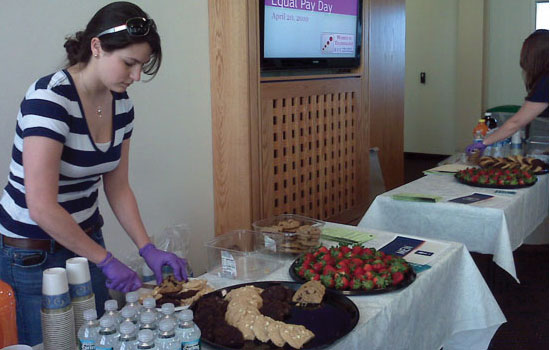Women in Technology hosts Equal Pay Day Awareness Event
Half cookies given to males to represent half pay
Michelle Cometa
CJ Allessio prepares some of the cookies she and the members of Women In Technology distributed recently to commemorate Equal Pay Awareness Day. Male guests received half cookies to symbolize the salary imbalance for men and women in similar jobs.
Is three-quarters of a macadamia nut and white-chocolate-chip cookie better than no cookie at all? Not if they are symbols of a portion of the salary given to women for equal jobs they do alongside men.
The RIT Women in Technology group marked April 20 as Equal Pay Awareness Day, the symbolic point at which a woman's salary finally catches up to a man's earnings from the previous year. To call attention to the wage gap that continues for males and females in some professions, the students in Women in Technology distributed cookies and information to more than 35 students, faculty and staff of the College of Applied Science and Technology about women’s earnings over their careers and some of the trends and stereotypes associated with the pay gap.
Members of Women in Technology set out trays of cookies and treats on two tables—one for men, one for women. A quarter to half of the men’s cookies were cut away to represent the lower percentage of salaries that women earn compared to men, explains CJ Allessio, a third-year packaging science student.
Whole cookies were given to female visitors. Allessio and Michelle Slifka, also a third-year packaging science student, distributed the cookies and talked to other students studying in the McGowan Commons about statistics such as:
One year out of college, women working full time earn 80 percent of what men make; 10 years later, women earn 69 percent as much as men.
The pay wage data came from a new study published by the American Association of University Women, “Why So Few?” The report is compilation of research done by the organization addressing topics such as stereotypes about women in STEM disciplines, spatial skills, college experiences and bias.
The RIT Equal Pay Awareness activity is one of several funded by a grant Women in Technology received from the American Association of University Women’s Campus Action Programs. RIT was one of 12 colleges to be awarded a Campus Action Project grant to alleviate the barriers for young women entering and staying in the science, technology, engineering and mathematics fields.
As part of the programming, members of Women in Technology developed a series of professional skills workshops, sponsored networking programs and led educational programs such as the one about the gender pay gap. Several of the programs this academic year were co-sponsored by other women in technology groups on campus—Women in Engineering and Women in Computing, organizations developed by the Kate Gleason College of Engineering and Golisano College of Computing and Information Sciences, respectively.
“The workshops address barriers women students face in persisting in the engineering disciplines,” says Elizabeth Dell, assistant professor, manufacturing and mechanical engineering technology/packaging science department, and the program director for the Engineering Technology Mentoring and Skills Workshops for Enhanced Retention, also referred to as EMPOWER. “These challenges include a limited peer group, limited role models and lack of self-confidence in their ability to succeed in the STEM fields.”
Despite gains women have made in STEM fields over the past few decades, they remain underrepresented in fields such as physics, engineering and computer science, Dell explains. Women make up 46 percent of the available workforce, but only 9 percent of engineers are women, she adds, and the goal is to increase this number.
This will also allow for all cookies—and eventually, salaries—to be full portions for both men and women.







